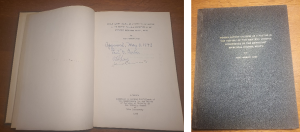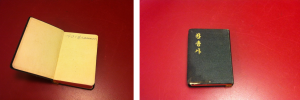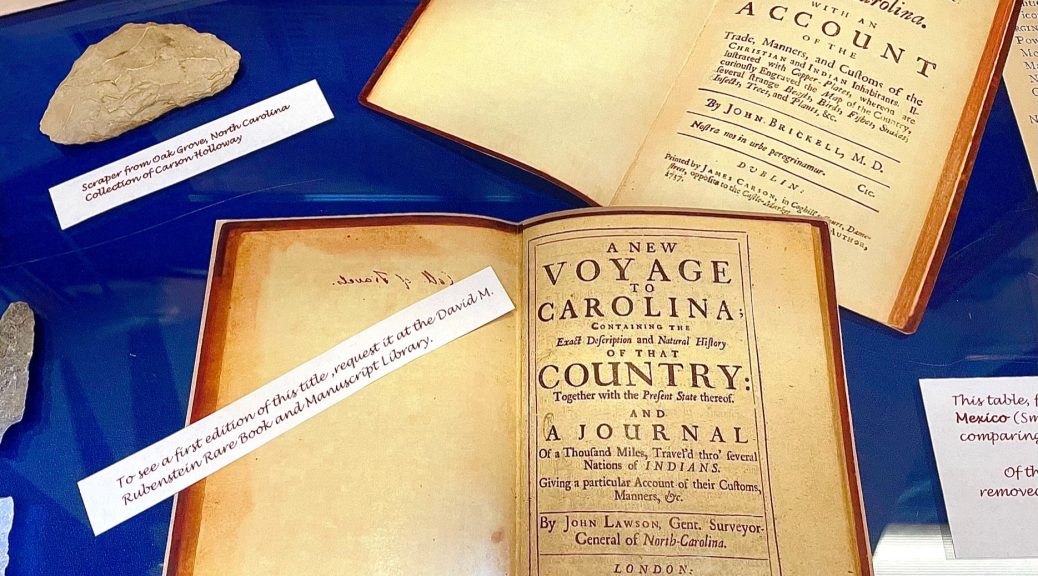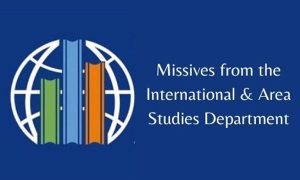 This blog post was written by Miree Ku, Korean Studies Librarian, Duke University Libraries. This is the second part of a series of stories about American Methodist Missionaries from Duke’s Korean Studies Collection. Part I of the series can be found here.
This blog post was written by Miree Ku, Korean Studies Librarian, Duke University Libraries. This is the second part of a series of stories about American Methodist Missionaries from Duke’s Korean Studies Collection. Part I of the series can be found here.
The First Duke Thesis on Korea and Its Connection to Methodist Missionaries
A long time ago, out of curiosity, I wondered when and by whom the first master’s or doctoral thesis about Korea was written at Duke University. Since Koreans began traveling to the United States for study abroad purposes only after Korea’s liberation from Japanese occupation in 1945, I assumed that the first thesis would have been written either around that time or after the start of the Korean War in 1950. In reality, the first master’s thesis on Korea at Duke was not written by a Korean but by an American back in 1934.
According to the original cataloging record, the author of Korea and Its Diplomatic Relations with the United States, was Charles W. Harrison (1878–1965), an American tenor and ballad singer. However, this was an unlikely choice for the author of a study of Korean-American diplomatic relations from 1866 to 1910. Doubting that they were the same person, I speculated that the author of the thesis might, instead, be the child of American missionaries. A quick perusal of the introduction confirmed my hunch and launched me on an extended search to find out more about this Duke graduate. The goal was not only to update the library catalog record to reflect the correct information, but also to learn more about the historical connection between Duke University and Methodist missionaries in Korea.
Relying on the extensive holdings of Duke’s Divinity School Library, I conducted additional research on missionaries dispatched to Korea from the late 19th century in all available missionary journals, examining them, page by page, for references to the Harrison who authored Duke’s first Korean studies thesis. During my research, I discovered numerous records, including The Missionary Journal, which published in Nashville, Tennessee, from 1868 to 1911, by the Executive Committee of Foreign Missions of the Presbyterian Church in the United States.
 In that serial publication, I discovered several references to Harrison’s parents. The first recorded mention dates from December 1900 and features a report on the status of American missionaries in Korea at the start of the 20th-century. This article is accompanied by a photograph of a gentleman named William Harrison (Korean name: 하 위렴, Ha Wi-ryeom). This Southern Presbyterian missionary came to Korea and took on multiple roles, including medical, educational, and evangelical work, as well as establishing mission stations. He was particularly active in the Honam region (southern inland of Korea), where he was deeply involved in building hospitals, schools, and churches. From 1896 to 1928, he served in Jeonju, Mokpo, and Gunsan, for a total of 32 years. The second recorded mention of William Harrison, from October 1905, includes an autobiographical article about his missionary activities in Gunsan, a southern area of Korea.
In that serial publication, I discovered several references to Harrison’s parents. The first recorded mention dates from December 1900 and features a report on the status of American missionaries in Korea at the start of the 20th-century. This article is accompanied by a photograph of a gentleman named William Harrison (Korean name: 하 위렴, Ha Wi-ryeom). This Southern Presbyterian missionary came to Korea and took on multiple roles, including medical, educational, and evangelical work, as well as establishing mission stations. He was particularly active in the Honam region (southern inland of Korea), where he was deeply involved in building hospitals, schools, and churches. From 1896 to 1928, he served in Jeonju, Mokpo, and Gunsan, for a total of 32 years. The second recorded mention of William Harrison, from October 1905, includes an autobiographical article about his missionary activities in Gunsan, a southern area of Korea.
William Harrison was married two times. His first wife, Linnie Davis Harrison, his was one of the first seven Southern Presbyterian missionaries to arrive in Korea in 1892. She was actively engaged in medical missions but tragically passed away in 1903 after contracting typhus. Harrison’s second wife, Margaret Jane Edmunds, was a pioneer in Korean nursing education, who was posthumously awarded the Order of Civil Merit, Dongbaek Medal (국민훈장 동백장) by the South Korean government in 2015.
Margaret Edmunds arrived in Korea as a Northern Methodist missionary in March 1903. She worked in nursing education at Severance Hospital, the oldest Western-style hospital in Korea, which was founded in 1885 as a royal hospital named “Gwanghyewon” (Korean: 광혜원; Hanja: 廣惠院) by Horace N. Allen, an American doctor and medical missionary.
In December 1903, Edmunds founded Korea’s first nursing school at Po Ku Nyo Kwan (보구녀관), Korea’s first modern hospital for women. This information is documented in Gajung Japji (가정잡지: “The Home Journal”), a women’s monthly magazine founded in 1906 by American missionary Robert Wilson (Korean name: 우월순).
Woman’s Missionary Friend, the missionary journal in which I found records on Edmunds, is also available at the Duke Divinity Library. This journal is a monthly magazine published by the Woman’s Missionary Friend, a women’s overseas missionary association of the Methodist Episcopal Church, originally called Heathen Woman’s Friend and published from 1869. It was renamed Woman’s Missionary Friend in 1896 and continued under that title until 1940. The magazine contains news and activities about missionaries working abroad, including an article on “Po Ku Nyo Kwan Hospital and Its Nursing Training School,” which appeared in Volume 1, Issue 4 of the magazine, dated September 25, 1906. This article includes a description of The Woman’s Foreign Missionary Society (WFMS) Hospital in Seoul, Korea, along with a photograph of the so-called “Salvation for All Women Institution” (普救女館, 보구녀관, Po Ku Nyo Kwan). Established by missionary Mary Scranton in October 1887, the Salvation of All Women Institution was Korea’s first modern women’s hospital and medical education institution for women and served as the precursor to both the Ewha Womans University College of Medicine and Medical Center, as well as the Ewha Womans University College of Nursing. In 1903, missionary nurse Margaret Edmunds founded a nursing education program at the Salvation of All Women Institution. This first formal nursing education institution in Korea laid the foundation for nursing education in Korea by introducing modern nurse uniforms, establishing the Korean term “간호사” as a translation of the English word “nurse,” and compiling the first Korean nursing textbook.
Edmunds married Harrison in 1908, and together they served in Mokpo, Korea. In 1911, the American missionary couple celebrated the birth of their son, Charles William Harrison (1911-1985), the individuals who went on to become the first person at Duke University to write a thesis about Korea.
The Second Duke Master’s Thesis on Korea
The second master’s thesis on Korea is also closely related to Methodist missionaries. In fact, it was written by Marion “Mack” Boyd Stokes Jr., the scion of a prominent South Carolinian Methodist family and the third son of a famous American missionary in Korea. As its title suggests, “Observations of Korean Native Religion and Social Practice” discusses indigenous Korean religions, including shamanism. The thesis author was born in 1911 in Wonsan, Korea. He earned his bachelor’s degree from Duke Divinity School (B.D., ’35), and his PhD from Boston University, and then went on to teach systematic theology and Christian doctrine at Emory University. In 1972, he became an American bishop of the United Methodist Church.
The author’s father, Rev. Marion B. Stokes (도마련, Do Maryon) worked as a missionary in Korea from 1907 to 1940. His memoirs were edited and published posthumously as Autobiography of Marion Boyd Stokes, D.D., a copy of which is housed in Duke’s Rare Book and Manuscripts Library.
Marion Boyd Stokes’ missionary work began with the nationwide “Million Souls for Christ” campaign, which aimed to evangelize one million Christian believers in Korea from September 1909 to March 1911. He was also interested in missionary-related publications. In January 1920, he launched the monthly magazine “Se-Gwang (세광)”, followed by “Sunday School Teachers (주일학교 선생)” in 1929, and “Sanctification (성화)”, another monthly Christian magazine in February 1935. He made notable contributions to the Korean missionary field until he was forcibly expelled by Japan in 1940, after which he returned to the United States. During the Korean War, he served as a Korean language interpreter for the U.S. military. Reverend Stokes’ other sons were also prominent in the United Methodist Church. His eldest son, John Lem Stokes II, was born in 1908 in Songdo, Korea (now part of North Korea). He graduated from Seoul Foreign School, Asbury College, and Duke Divinity School with a Master of Divinity degree, and received his Ph.D. from Yale University. He later served as president of Pfiffer College and vice president of the University of North Carolina. In 1998, he edited and rewrote his father’s autobiography (cited above). Reverend Stokes second son, James C. Stokes, became the editor of the North Carolina Christian Advocate, the official journal of the North Carolina Methodist Church. The youngest son, Charles D. Stokes, followed his father’s footsteps as a missionary in Korea, where he was known by his Korean name, 도익서 (Do Ik-Seo). He founded the Methodist Theological College in Daejeon (now Mokwon University, 목원대학) to train rural students. During the Korean War, he worked tirelessly on refugee transport and relief efforts, particularly for war orphans. After his death, the Korean government posthumously awarded him the National Merit Medal for his contributions.
Reverend Stokes’ other sons were also prominent in the United Methodist Church. His eldest son, John Lem Stokes II, was born in 1908 in Songdo, Korea (now part of North Korea). He graduated from Seoul Foreign School, Asbury College, and Duke Divinity School with a Master of Divinity degree, and received his Ph.D. from Yale University. He later served as president of Pfiffer College and vice president of the University of North Carolina. In 1998, he edited and rewrote his father’s autobiography (cited above). Reverend Stokes second son, James C. Stokes, became the editor of the North Carolina Christian Advocate, the official journal of the North Carolina Methodist Church. The youngest son, Charles D. Stokes, followed his father’s footsteps as a missionary in Korea, where he was known by his Korean name, 도익서 (Do Ik-Seo). He founded the Methodist Theological College in Daejeon (now Mokwon University, 목원대학) to train rural students. During the Korean War, he worked tirelessly on refugee transport and relief efforts, particularly for war orphans. After his death, the Korean government posthumously awarded him the National Merit Medal for his contributions.








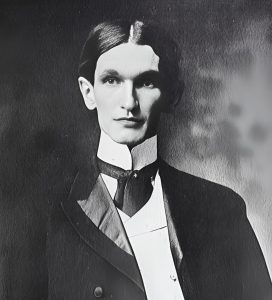







 Join us for two author talks this semester and the launch of a new book series from Duke University Press,
Join us for two author talks this semester and the launch of a new book series from Duke University Press, 






